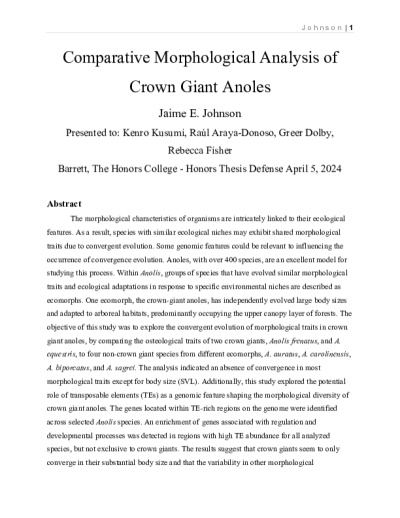Theses and Dissertations
Filtering by
- Creators: School of Life Sciences

Members of the Delphinidae family are widely distributed across the world’s oceans. We used a viral metagenomic approach to identify viruses in orca (Orcinus orca) and short-finned pilot whale (Globicephala macrorhynchus) muscle, kidney, and liver samples from deceased animals. From orca tissue samples (muscle, kidney, and liver), we identified a novel polyomavirus (Polyomaviridae), three cressdnaviruses, and two genomoviruses (Genomoviridae). In the short-finned pilot whale we were able to identify one genomovirus in a kidney sample. The presence of unclassified cressdnavirus within two samples (muscle and kidney) of the same animal supports the possibility these viruses might be widespread within the animal. The orca polyomavirus identified here is the first of its species and is not closely related to the only other dolphin polyomavirus previously discovered. The identification and verification of these viruses expands the current knowledge of viruses that are associated with the Delphinidae family.

Heat shock factors (HSFs) are transcriptional regulators that play a crucial role in the cellular response to environmental stress, particularly heat stress. Understanding the evolution of HSFs can provide insights into the adaptation of organisms to their changing environments. This project explored the evolution of HSFs within tetrapods, a group of animals that includes amphibians, reptiles, turtles, and mammals. Through an analysis of the available genomic data and subsequent genomic methodologies, HSFs have undergone significant changes throughout tetrapod evolution, as evidenced by loss events observed in protein sequences of the species under examination. Moreover, several conserved and divergent regions within HSF proteins were identified, which may reflect functional differences between HSFs in different tetrapod lineages. Our findings suggest that the evolution of HSFs has contributed to the adaptation of tetrapods to their diverse environments and that further research on the functional and regulatory differences between HSFs may provide a better understanding of how organisms cope with stress in heat-stressed environments.




Bats are a highly diverse mammal species with a dense virome and fascinating immune system. The following project utilizes metagenomics in order to identify DNA viruses present in populations of silver-haired bats and Mexican free-tailed bats from southern Arizona. A significant number of DNA viruses and novel viruses were identified in the Cressdnaviricota phylum and Microvirdae family.
